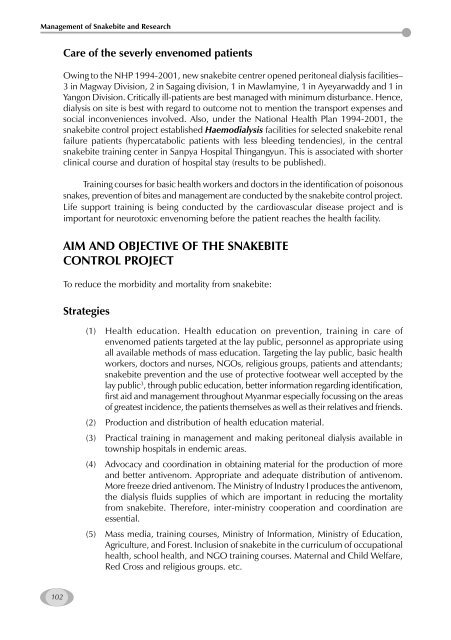Management of Snakebite and Research Management of Snakebite ...
Management of Snakebite and Research Management of Snakebite ...
Management of Snakebite and Research Management of Snakebite ...
You also want an ePaper? Increase the reach of your titles
YUMPU automatically turns print PDFs into web optimized ePapers that Google loves.
<strong>Management</strong> <strong>of</strong> <strong>Snakebite</strong> <strong>and</strong> <strong>Research</strong><br />
102<br />
Care <strong>of</strong> the severly envenomed patients<br />
Owing to the NHP 1994-2001, new snakebite centrer opened peritoneal dialysis facilities–<br />
3 in Magway Division, 2 in Sagaing division, 1 in Mawlamyine, 1 in Ayeyarwaddy <strong>and</strong> 1 in<br />
Yangon Division. Critically ill-patients are best managed with minimum disturbance. Hence,<br />
dialysis on site is best with regard to outcome not to mention the transport expenses <strong>and</strong><br />
social inconveniences involved. Also, under the National Health Plan 1994-2001, the<br />
snakebite control project established Haemodialysis facilities for selected snakebite renal<br />
failure patients (hypercatabolic patients with less bleeding tendencies), in the central<br />
snakebite training center in Sanpya Hospital Thingangyun. This is associated with shorter<br />
clinical course <strong>and</strong> duration <strong>of</strong> hospital stay (results to be published).<br />
Training courses for basic health workers <strong>and</strong> doctors in the identification <strong>of</strong> poisonous<br />
snakes, prevention <strong>of</strong> bites <strong>and</strong> management are conducted by the snakebite control project.<br />
Life support training is being conducted by the cardiovascular disease project <strong>and</strong> is<br />
important for neurotoxic envenoming before the patient reaches the health facility.<br />
AIM AND OBJECTIVE OF THE SNAKEBITE<br />
CONTROL PROJECT<br />
To reduce the morbidity <strong>and</strong> mortality from snakebite:<br />
Strategies<br />
(1) Health education. Health education on prevention, training in care <strong>of</strong><br />
envenomed patients targeted at the lay public, personnel as appropriate using<br />
all available methods <strong>of</strong> mass education. Targeting the lay public, basic health<br />
workers, doctors <strong>and</strong> nurses, NGOs, religious groups, patients <strong>and</strong> attendants;<br />
snakebite prevention <strong>and</strong> the use <strong>of</strong> protective footwear well accepted by the<br />
lay public3 , through public education, better information regarding identification,<br />
first aid <strong>and</strong> management throughout Myanmar especially focussing on the areas<br />
<strong>of</strong> greatest incidence, the patients themselves as well as their relatives <strong>and</strong> friends.<br />
(2) Production <strong>and</strong> distribution <strong>of</strong> health education material.<br />
(3) Practical training in management <strong>and</strong> making peritoneal dialysis available in<br />
township hospitals in endemic areas.<br />
(4) Advocacy <strong>and</strong> coordination in obtaining material for the production <strong>of</strong> more<br />
<strong>and</strong> better antivenom. Appropriate <strong>and</strong> adequate distribution <strong>of</strong> antivenom.<br />
More freeze dried antivenom. The Ministry <strong>of</strong> Industry I produces the antivenom,<br />
the dialysis fluids supplies <strong>of</strong> which are important in reducing the mortality<br />
from snakebite. Therefore, inter-ministry cooperation <strong>and</strong> coordination are<br />
essential.<br />
(5) Mass media, training courses, Ministry <strong>of</strong> Information, Ministry <strong>of</strong> Education,<br />
Agriculture, <strong>and</strong> Forest. Inclusion <strong>of</strong> snakebite in the curriculum <strong>of</strong> occupational<br />
health, school health, <strong>and</strong> NGO training courses. Maternal <strong>and</strong> Child Welfare,<br />
Red Cross <strong>and</strong> religious groups. etc.









